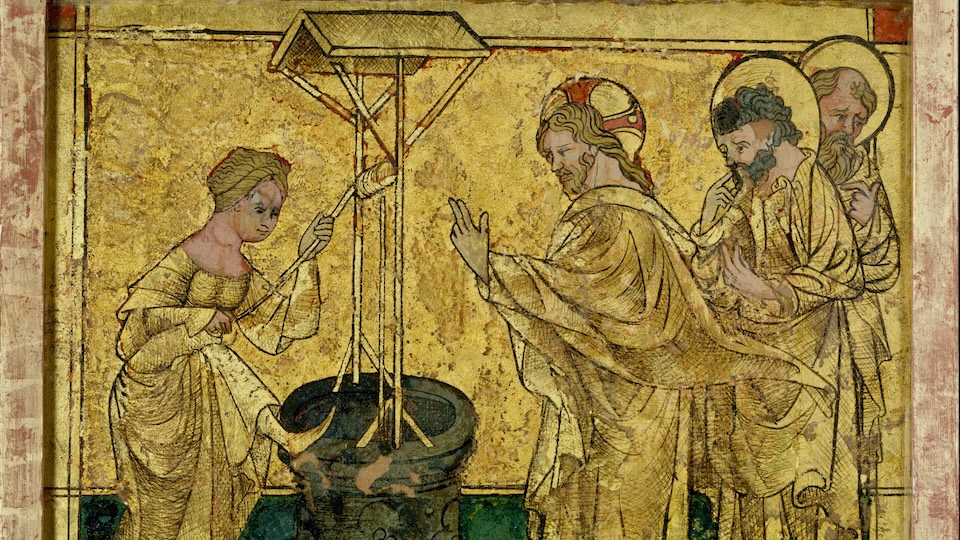Pope Francis' Catechesis – March 26, 2025
Pope Francis
Wednesday, March 26, 2025

Pope Francis continued the second section of his cycle of catechesis on "Jesus Christ our Hope," as part of the Jubilee 2025, on encounters with Christ in the Gospels. This week, he reflected on Jesus' encounter with the Samaritan woman at the well, saying that "Jesus waits for us and lets Himself be found precisely when we think that there is no hope left for us."Read the prepared text of his catechesis below. Dear brothers and sisters, After contemplating the encounter between Jesus and Nicodemus, who went in search of Jesus, today we will reflect on those moments in which it seems that He is in fact waiting right there, at that crossroads in our life. They are encounters that surprise us, and at the beginning we are perhaps even a little diffident; we try to be prudent and to understand what is happening. This was probably also the experience of the Samaritan woman, mentioned in chapter four of John’s Gospel (cf. 4:5-26). She did not expect to find a man at the well at noon; indeed she hoped to find no one at all. In fact, she goes to fetch water from the well at an unusual hour, when it is very hot. Perhaps this woman is ashamed of her life, perhaps she has felt judged, condemned, not understood, and for this reason she has isolated herself, she has broken off relations with everyone. To go to Galilee from Judea, Jesus would have had to choose another road and not pass through Samaria. It would also have been safer, given the tense relations between the Jews and the Samaritans. Instead, He wants to pass through there, and stops at that very well, right at that time! Jesus waits for us and lets Himself be found precisely when we think that there is no hope left for us. The well, in the ancient Middle East, is a place of encounter, where at times marriages are arranged; it is a place of betrothal. Jesus wants to help this woman understand where to find the true answer to her desire to be loved. The theme of desire is fundamental to understanding this encounter. Jesus is the first to express His desire: “Give me a drink!” (v. 10). For the sake of opening a dialogue, Jesus makes Himself appear weak, in order to put the other person at ease, making sure that she is not frightened. Thirst is often, even in the Bible, the image of desire. But Jesus here thirsts first of all for the woman’s salvation. “He who was asking drink,” says St. Augustine, “was thirsting for the faith of the woman herself” (Homily 15,11). Whereas Nicodemus had gone to Jesus at night, here Jesus meets the Samaritan woman at midday, the time when there is most light. It is indeed a moment of revelation. Jesus makes Himself known to her as the Messiah and also sheds light on His life. He helps her to reread her history, which is complicated and painful: she has had five husbands and is now with a sixth who is not a husband. The number six is not accidental, but usually indicates imperfection. Perhaps it is an allusion to the seventh bridegroom, the one who will finally satiate this woman’s desire to be truly loved. And that bridegroom can only be Jesus. When she realizes that Jesus knows her life, the woman shifts the conversation to the religious question that divided Jews and Samaritans. This happens sometimes to us too when we pray: at the moment in which God is touching our life, with its problems, we lose ourselves at times in reflections that give us the illusion of a successful prayer. In reality, we have raised barriers of protection. However, the Lord is always greater, and to that Samaritan woman, to whom according to cultural precepts He should not even have spoken, He gives the highest revelation: He speaks to her of the Father, who is to be adored in spirit and truth. And when she, once again surprised, observes that on these things it is better to wait for the Messiah, He tells her: “I am he, the one who is speaking with you” (v. 26). It is like a declaration of love: the One you are waiting for is Me; the One who can finally respond to your desire to be loved. At that point the woman runs to call the people of the village, because mission springs precisely from the experience of feeling loved. And what proclamation could she have brought, if not her experience of being understood, welcomed, forgiven? It is an image that should make us reflect on our search for new ways to evangelize. Just like a person in love, the Samaritan forgets her water jar, leaving it at Jesus’ feet. The weight of that jar on her head, every time she returned home, reminded her of her condition, her troubled life. But now the jar is left at Jesus’ feet. The past is no longer a burden; she is reconciled. And it is like this for us too: to go and proclaim the Gospel, we first need to set down the burden of our history at the feet of the Lord, to consign to Him the weight of our past. Only reconciled people can bring the Gospel. Dear brothers and dear sisters, let us not lose hope! Even if our history appears burdensome, complicated, perhaps even ruined to us, we always have the possibility of consigning it to God and setting out anew on our journey. God is merciful, and awaits us always! Text courtesy of the Libreria Editrice Vaticana. To read the full catalogue of Pope Francis' General Audiences, visit our General Audience blogroll.
Related Articles:
Category: Featured, Liturgical, Special Events
Tag: British Columbia, episcopate, Msgr. Stephen Jensen, Prince George
Visit local pilgrimage sites this Jubilee Year
Thursday, January 30, 2025
 Maria Montemayor
Maria Montemayor
For the Jubilee of Hope, there are designated local pilgrimage sites in every country, and Canada is no exception. How is a local pilgrimage site determined? The local bishop can designate any parish, shrine, or basilica in his territory as a Jubilee Year pilgrimage site.
Creating Catholic streetwear
Thursday, January 9, 2025
 Maria Montemayor
Maria Montemayor
Fashion and clothing designed to draw people closer to God can inspire and even sanctify others. Nate Nagello, the CEO and owner of the Toronto-based Sanctified Collective, hopes the clothing he creates can provide opportunities for conversation, engagement, and evangelization.
When do you pray the Rosary?
Wednesday, December 4, 2024
 Maria Montemayor
Maria Montemayor
The Rosary is powerful: many graces can be bestowed upon those who pray it, and it can also offer special protection. Reciting the Rosary aloud in church and praying for the pope’s intentions can grant the supplicant a plenary indulgence.
What does it mean to be pro-life?
Tuesday, October 29, 2024
 Maria Montemayor
Maria Montemayor
This month on Behold, we have a special Lives Lived for Life episode featuring the stories of various pro-life advocates and individuals.
Review of The Forge
Thursday, August 22, 2024
 Maria Montemayor
Maria Montemayor
The movie is a testament to how a person’s life can transform in a year due to the power of prayer and the positive influence of a mentor.
SUPPORT LABEL
$50
$100
$150
$250
OTHER AMOUNT
DONATE













